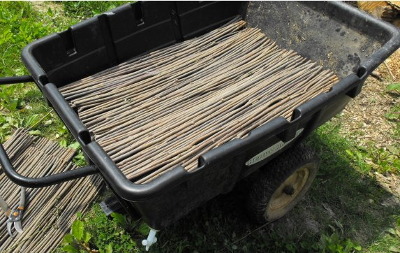
Worm bin failures
The
invertebrate side of our farm did very badly in 2010. First of
all, we never got to our project of creating a black
soldier fly bin because we just didn't have enough excess food
scraps to make it worthwhile. And, yes, I actually managed to
kill our worms.
In 2009, we had a simple,
under-the-sink worm bin that worked quite well, but
at certain times of the year it was overloaded by the scraps our
chickens wouldn't eat. We could tell because we ended up with a
fruit fly infestation, and we figured the clear solution was to build a
bigger bin. A bigger bin would not only allow us to compost
additional waste, it would be less sensitive to environmental extremes,
so we could keep it outside year round.
Mark turned
our heavy hauler into a worm bin, but due to my bad advice,
the faucet to drain off the worm tea clogged up and the bottom of the
bin became waterlogged. Since  the
bin was in the sun, the top of the bin got too hot, and the poor worms
were stuck with the choice of being baked or drowned. Meanwhile,
I had added a lot of horse manure from the neighbor to get the bin
going quickly, but before the worms had time to really work on it I ran
out of compost and had to take the manure back off to put on the
garden. The result was total eradication of worms from the bin
--- drat!
the
bin was in the sun, the top of the bin got too hot, and the poor worms
were stuck with the choice of being baked or drowned. Meanwhile,
I had added a lot of horse manure from the neighbor to get the bin
going quickly, but before the worms had time to really work on it I ran
out of compost and had to take the manure back off to put on the
garden. The result was total eradication of worms from the bin
--- drat!
Our potted plants have
especially missed the nutrient-rich worm tea, so we definitely plan to
remedy our worm situation in 2011. We may make something as
simple as Binet
Payne's medium-scale bins, but adding in an ability to
drain off the tea for our plants, and we may try out worm towers as well. This time, I
plan to go ahead and buy a paper shredder so that we'll have a more
optimal bedding too. And if we can talk a local school into
giving us their scraps, we'll also have enough nutrient-rich waste to
experiment with black soldier flies.
This post is part of our 2010 experiments lunchtime series.
Read all of the entries:
|
Want more in-depth information? Browse through our books.
Or explore more posts by date or by subject.
About us: Anna Hess and Mark Hamilton spent over a decade living self-sufficiently in the mountains of Virginia before moving north to start over from scratch in the foothills of Ohio. They've experimented with permaculture, no-till gardening, trailersteading, home-based microbusinesses and much more, writing about their adventures in both blogs and books.
Want to be notified when new comments are posted on this page? Click on the RSS button after you add a comment to subscribe to the comment feed, or simply check the box beside "email replies to me" while writing your comment.
- Remove comment
- Remove comment
